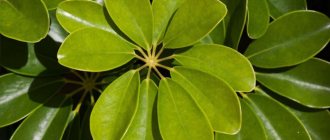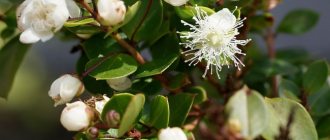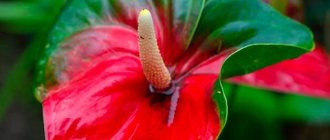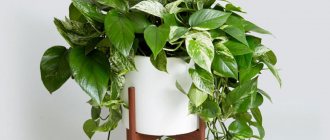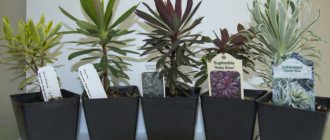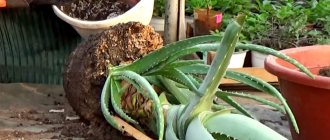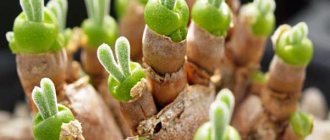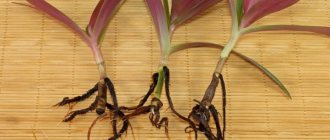Do you want to grow a beautiful indoor Epipremnum flower? Read useful information about this vine in this article.
Indoor flowers decorate our lives. We love to take care of them, watering and replanting, and the plants thank us with their lush flowering and good growth.
Read in another article on our website about the home flower Pedilanthus - care, replanting, signs, benefits and harm to humans .
Creepers are one of the most beautiful indoor flowers. They are easy to grow and do not require much time to care for. Find out more about the indoor flower Epipremnum pinnate, especially if you want to plant it at home. This article describes the proper care of this plant. Read on.
Where is the birthplace of the indoor flower “Epipremnum pinnate”: types, varieties, photos
Indoor flower "Epipremnum pinnate"
Epipremnum (from the Latin Epipremnum, which means "on the trunks", as this is associated with their usual habitat), or it is also called scindapsus. This plant is one of the most popular varieties of perennial vines. Belongs to the Araceae family (from the Latin “ Amorpho ” - “ shapeless ” and “ Phallus ” - “ offspring, shoot ”). Description of indoor flower Epipremnum pinnate :
- Under normal conditions, the flower can reach up to 38-40 meters in length, spread widely on the ground or be attached to the trunks of other trees.
- If we are talking about a home flower, then it can grow up to 4.5 meters long. It is easy to care for, which is a plus for lovers of house plants.
- Every year this plant can add up to 45 cm .
- Blooms only in its natural habitat. This usually happens from spring until late autumn.
- The flowers themselves grow in the form of a cob, so they do not carry any value. They are valued more as decorative.
The tropics of Southeast Asia, namely the Solomon Islands of the Malay Archipelago , as well as Indonesia the birthplace of Epipremnum .
Indoor flower Epipremnum pinnatum (from the Latin Epipremnum pinnatum) is a plant that is a kind of vine, the leaves of which are strewn with various yellow-green spots. Under normal conditions, the stems can easily reach their legal 2 meters in length. They practically don't bloom. More likely, they never even bloom. Look at the photo how beautiful a flower looks when it grows at home:
Indoor flower "Epipremnum pinnate"
Epipremnum – photo
Look how wonderful and varied epipremnum looks in the interior. We have compiled a large gallery with different types and varieties!
Photo: kk.mcchatel.ch Photo: nocnoc.com
Photo: botanichka.ru Photo: darvin-market.ru Photo: floravdome.ru
Photo: fiftyflowers.ru
Photo: sdelai-lestnicu.ru
Photo: botanichka.ru
Photo: youtube.com
Photo: m.alibaba.com
Photo: fitosystems.ru
Photo: saddrakona.ru Photo: domashniecvety.ru Photo: stroytvoydom.ru Photo: commons.m.wikimedia.org Photo: sdelai-lestnicu.ru
Photo: bg.digital-revolution.at
Photo: uz.pastureone.com
Photo: plantsinyogapants.com
Photo: jenbosen.com Photo: constantdelights.com
Photo: krugosvetka.icu
Photo: anandabazar.com
Photo: tepliepol.ru
Photo: guide.alibaba.com Photo: pinterest.com.au
Photo: pinterest.ru
Did you like the post? Subscribe to our channel in Yandex.Zen, it really helps us in our development!
Indoor flower Epipremnum: types and varieties
Indoor flower Epipremnum aureum (from the Latin Epipremnum aureum) is a plant that is most often chosen for growing at home. The stems can reach up to 1-2 meters in length. But this is only under normal conditions. On the stems you can often see greenish leaves with a certain golden tint. It only becomes stronger if the plant is close enough to the light.
Indoor flower Epipremnum
Here is a list of popular varieties of this type:
Epipremnum Golden Pothos
- Golden Pothos - Its leaves are usually yellow-gold in color.
Epipremnum Marble Queen
- Epipremnum Thai Marble Queen - moderately golden, sometimes with a white tint, the relevance is in the white strokes on the leaves.
Epipremnum Enjoy
- Epipremnum Enjoy (joy-n-joy) - its leaves are exclusively green in color, with white streaks and strokes in some cases.
Epipremnum Pearl and Jade
- Epipremnum Pearl and Jade - refers to selection based on the primary Marble Queen, the color of the leaves is always very diverse.
Epipremnum Aureum (aureum)
- Epipremnum Aureum (aureum) - leaves are succulent with yellow splashes. This vine spreads as usual, but the leaves point upward.
Epipremnum Variegate Pinnatum
- Epipremnum Variegata Pinnatum - the leaves are beautiful, large, as if covered with a white mesh.
Epipremnum Happy Leaf
- Epipremnum Happy Leaf is a beautiful indoor vine with white leaves. It looks very stylish and interesting in the house, and perfectly complements the appearance of other green plants.
Epipremnum Skeleton
- Epipremnum Skeleton - its appearance resembles a skeleton. Holes in the leaves look interesting, as nature itself made them.
Epipremnum Godzilla
- Epipremnum Godzilla - When you first see this flower, you might think it has wilted. Its leaves are slightly curled and dark green in color. But it does not fade, this is the usual and normal appearance of the flower of this species. Attracts attention against the background of other indoor plants.
Epipremnum Neon
- Epipremnum Neon is another beautiful variety that stands out from other flowers. The leaves actually seem to glow neon.
Epipremnum maculata
- Epipremnum spotted, or you can also find the name “painted” (from the Latin. Scindapsus pictus) - a vine that grows up to 15 meters . The surface of its stem on a young plant is very smooth, but with increasing age, it begins to form numerous growths. The leaves are ovoid in shape, slightly elongated in length by approximately 12-15 cm , and only 6-7 cm .
Epipremnum Exotica
The most famous varieties at the moment: Argyraeus (silver spots that are scattered very chaotically) and Exotica (leaves with silver dots and strokes, unusual shape).
Types of home epipremnum with photos and names
Epipremnum pinnatum
It is a climbing vine decorated with marbled leaf plates with a yellow-green color and very long shoots. The stems grow up to 2 meters in length. Almost never blooms. Varieties: Aureum and Marble Quint.
Epipremnum aureum
It is one of the most popular varieties of decorative flowers. A distinctive feature is the dark green leathery leaves, decorated with various spots and stripes of golden color. The vine stems eventually reach 6 meters. Varieties: Golden Pothos, Pearl and Jade, N Joy and Marble Queen.
Epipremnum spotted or painted Scindapsus pictus
This is a vine that grows up to 15 meters in length. The surface of the stem on a young plant is smooth, but as its age increases, numerous growths begin to form. The leaf blades are ovoid in shape, elongated by 12-15 cm in length and 6-7 cm in width. The most famous varieties: Argyraeus and Exotica.
Epipremnum: beneficial properties
Botanical enthusiasts claim that growing epipremnum at home allows you to fill the house with vivacity and excellent mood even on the grayest and rainiest days. Epipremnum has beneficial properties. Here are some scientifically proven facts about this plant:
- It absolutely definitely increases the endurance of the human body just by being nearby.
- It has a stimulating effect on the mind, increases the intensity of its development.
- It has a positive effect on people’s well-being, both on an emotional and physical level.
In addition to the fact that this plant is beautiful, it also has a beneficial effect on humans. However, many people are afraid to grow it at home according to signs. Read on.
Mistakes and care problems
Growing epipremnum can cause some problems, especially if not properly cared for at home.
| Problem | Cause |
| The appearance of black spots on the leaf blades. Growth slowdown | Stagnation of water in the soil, high air humidity |
| Yellowing and drying of leaf tips | Dry soil, low humidity |
| Leaf color becomes pale | Lack of light |
| Formation of brown spots on leaves | Hitting the liana with the midday sun |
| Wilting and slow growth | Root system rotting |
Epipremnum: signs
Before reading, we warn you that signs only work with those people who believe in them.
- They say that Epipremnum is the plant that will separate you from your husband. All these plants are very dangerous for those who do not want to live alone all their lives.
- This is also one of those very representatives of the “mozhegons” . If you are single, you will not be able to get married if you have such a flower growing at home.
Still, it’s worth clarifying once again that no flower is to blame for the fact that your personal life is not going well. That's why some people believe in omens, while others don't, and plant such beauty in their homes.
Benefits and harms
Epipremnum is one of the strongest air purifiers.
It absorbs a variety of harmful substances, including carbon monoxide.
Thanks to this plant, the air is enriched with organic and mineral compounds that have a beneficial effect on human health.
"Scindapsus" provides a positive energy atmosphere in the room.
People living in a house where this vine grows become less irritable and less likely to become depressed. This tropical beauty also fills the atmosphere with the energy of creation, indispensable for people of creative professions.
Important! The harm of Epipremnum is its toxicity, but you can easily avoid this harm by handling the plant carefully.
Epipremnum plant: features of growing at home
As mentioned earlier, caring for the Epipremnum is very simple. It is for this reason that this flower can often be found in the houses and apartments of people who are landscaping their “fortress”. Features of growing at home:
- The most important thing is to provide a place where Epipremnum will stand. It should be in diffused lighting, with a pot and soil suitable for its characteristics.
- It is also necessary to ensure optimal temperature and air humidity for the plant, sometimes timely feeding with fertilizers and watering.
- Do not touch the leaves under any circumstances when the flower is dormant, otherwise it may die.
These are the most important requirements for caring for a plant. As you may have noticed, they do not have any special features. Read more about care below.
Scindapsus perakensis
A rare species with glossy, long, arrow-shaped leaves of rich green color. Easy to grow, shade-tolerant variety.
Scindapsus Perakensis
Interesting varieties Scindapsus Pinnatum = Epipremnum Pinnatum.
The leaves of this species separate naturally as it grows, just like its aroid relatives, Monstera, Syngonium and Philodendron.
Due to the external similarity of adult leaves, sometimes you can get confused in determining not even the variety, but the type of plant!
Indoor flower scindapsus Epipremnum: care at home
Indoor flower scindapsus epipremnum
If you have taken up growing an indoor flower scindapsus epipremnum , then you should know the following basics of care at home:
- In summer you need to keep the temperature no higher than 18-24 degrees Celsius , and in winter - no lower than 13 degrees Celsius.
- Air humidity should be high enough. Of course, the plant is drought-resistant, but this does not change the fact that it has a very hard time living in such conditions. It is worth spraying its leaves from time to time so that development and growth remain positive.
- It was mentioned above that this plant feels best in diffused light, but the flower can also adapt to partial shade.
- Water at least once every 5 days in summer, and in winter - at least once a week with warm water.
- The soil should consist of sand, peat, humus and even leaf soil.
- From spring until autumn, it is advisable to feed the plant with various liquid mixtures for indoor plants - once every 3 weeks . There is no need to do this in winter, which is very convenient.
- Replant a young plant annually - in early April, and an adult - once every 2 years .
- It is best to propagate by cuttings. To speed up the process, it is better to use a container of water or a peat mixture with moss.
Important : The plant reacts very painfully to drafts and gases, and also needs support as it grows. It is recommended to carry out pruning in the spring; cut branches only to half their length.
Scindapsus pictus or Scindapsus pictus
A very popular and widespread species.
The leaf of a mature plant is dull dark green with a thin white edge. Silvery-white spots of varying sizes are scattered on the surface of the leaves. A characteristic feature of the species is the asymmetry of the leaves in relation to the central vein.
In good conditions and high humidity, the leaves of Scindapsus rasperus can grow up to 15 cm.
Scindapsus pictus
Varieties of Scindapsus pictus:
Scindapsus Argyraeus
A popular variety is Scindapsus argyraeus. Wide, small leaves with small white spots.
Scindapsus pictus Argyraeus
Scindapsus Pictus Trebie
A popular variety - large asymmetrical leaves with a bright contrasting pattern - spots, dashes, stripes. The leaf is slightly embossed and has a velvety surface. It is unpretentious, tolerates shade, but the brightness of the pattern depends on the intensity and duration of lighting.
Scindapsus pictus Treble
Scindapsus Pictus Silvery Ann or Satin Pothos
Silvery inclusions almost completely cover the dull green surface of the leaves. Of all the colored Scindapsus cultivars, Silver Ann has the most extensive coverage of the main green background spots. Sometimes the surface of the leaf is completely silver.
Scindapsus Pictus Silver Ann
Blooming liana Epipremnum
As mentioned above, the flowering of the Epipremnum vine is not the main advantage of this plant. It belongs to the Araceae family, which means that, like all other representatives of this family, Epipremnum is characterized by an inflorescence in the form of a spadix, the length of which is no more than 6 cm .
The period of such flowering, specific to us, occurs in the spring-autumn period. This occurs exclusively in wild (natural) conditions. At home, the plant plays the role of a decorative foliage flower.
Description of the plant
Among plants that have phytoncidal properties and can improve air quality, epipremnum is one of the absolute favorites. But his decorative talents are also unique. Epipremnum is ideal for creating screens, screens and figures due to the “tenacity” and flexibility of the shoots.
The botanical name epipremnum perfectly reveals the growth pattern of the hemi-epiphyte (from the Greek “on the trunks”), but the plant is still often called scindapsus, or pothos .
Epipremnums are evergreen climbing vines from the Araceae family with very thin and flexible shoots up to 2-3 m in length. Two types of gradually lignifying aerial roots develop on the stems - feeding and clinging. In the internodes on young branches, oblong ridges and remnants of fallen leaves are noticeable; old shoots gradually become lignified.
The leaves of epipremnums are strikingly evenly distributed along the shoots and increase in size with age. In nature, old leaves change shape to pinnately dissected or perforated, showing off cuts along the central vein. But in indoor conditions this rarely happens.
Delicately leathery, not too dense, sitting on long petioles, heart-shaped or oval leaves seem perfectly symmetrical due to their strongly pointed tip. The glossy shine of the surface is a constant feature of epipremnums, as is the presence of spots and patterns on the leaves. The basic green tone is always bright, and variegated, unevenly scattered white or yellow patterns make it even more elegant.
Indoor epipremnums almost never bloom. Inflorescence-cobs with dirty light green blankets can form only in old bushes with formed “adult” leaves.
Epipremnum belongs to poisonous plants that require care, because contact with juice can cause irritation not only of the mucous membranes, but also of the skin.
Epipremnum aureum, variety 'Marble Queen'. © Flower meadow
Epipremnum aureum, variety 'Enjoy'. © Flower meadow
Epipremnum aureum, variety 'Golden Pothos'. © thomsons
Temperature regime for the Epipremnum flower when kept at home
The temperature regime of the Epipremnum flower when maintaining a house is very important. He is very sensitive to airflow and loves warmth, but it is also difficult for him to tolerate heat.
In the summer season, the most optimal temperature for the plant is 18-25 degrees Celsius , and the air temperature in winter should not fall below 14 degrees Celsius . This is important, because low temperatures have a very bad effect on the well-being and growth of Epipremnum. Don't forget that the air humidity should also be high.
Spraying the Epipremnum plant
From time to time it is recommended to wipe the leaves with a damp cloth, or give the flower the opportunity to take a full “shower” under running warm water.
Measures such as spraying the plant are usually introduced in particularly hot weather. In summer, Epipremnum needs this procedure every other day or two. Ideally - every day. Such procedures will not be superfluous during the heating season. Especially if you choose a place for the flower near a radiator or some other heating device.
Epipremnum: lighting and watering
Epipremnum does not tolerate direct sunlight. The plant will thrive under diffused light and even in twilight (in some cases.)
If you choose between an east and west window, it is better to place it on the windowsill on the east side. But if for some reason you wanted to designate the western window as the flower’s place of residence, then there is nothing wrong with that. The difference is very small, just spray the plant more often if the sun is very bright.
Worth knowing: Do not keep the plant in northern rooms and in rooms with minimal lighting. Shade is normal, but darkness will significantly deteriorate the plant's appearance. For example, the leaves will not be bright and noticeable, and the shoots will be long and begin to creep unattractively to the sides.
As for watering, you should not water the plant too often. The soil should be given time to dry a little. Otherwise, there is a high probability that the roots will begin to rot. A moisture-absorbing, heavy soil structure can create an even greater risk.
Ideal watering plan:
- Warm water once every 5 days in summer
- Warm water once a week in winter
Below is even more useful information. Read on.
Pot and soil for indoor Epipremnum flower
Indoor flower Epipremnum
The pot for the indoor flower Epipremnum should be chosen carefully. It should be wide, but not quite deep. Such criteria can be explained by the shallow root system of the plant. Also worth knowing:
- From too much water, the root system of the flower will begin to rot. To avoid this, be sure to select a container with holes for excess water to escape during and after watering.
- From an aesthetic point of view, a healthy Epipremnum will look good in a white plastic pot with curves like tulip leaves. In addition, such containers for planting indoor plants are among the cheapest and most affordable.
Air and moisture permeability are the most basic criteria for the normal content of Epipremnum in the soil. When planting, it is advisable to use the most common flower soil. For further transplants, you can use mixtures consisting of humus, peat, turf soil, and coarse sand. But in any case, no matter what mixture you make, you should put a layer of expanded clay on the bottom of the pot to avoid the risk of rotting of the plant roots.
Reproduction of Epipremnum
Quick and efficient rooting of cuttings makes it easy to propagate and renew epipremnums. Any apical or stem cutting with 2 or 3 leaves is enough, which can be rooted both in water and in a substrate under a hood.
Layings of epipremnum also take root easily: the branches are fixed in the soil with a staple in a separate pot, and after rooting they are separated as independent ones. Mature bushes can be divided.
To propagate such a plant by apical cuttings, you need to cut off the upper part of the stem, which should have 2 or 3 leaf plates.
PS Feel free to share your experience of growing Epipremnum , express your opinion in the comments, like and subscribe to our Zen channel. This will help novice gardeners gain more information and knowledge.
We hope that our article and your personal experience left in the comments will make the difficult work of beginning gardeners easier and will not allow them to waste time.
Feeding and fertilizing the houseplant Epipremnum
In winter, it is necessary to provide additional lighting for the Epipremnum indoor plant. Then it will be enough to apply additional fertilizers in the form of universal liquid mixtures once every three weeks .
In the absence of proper lighting, the plant will have to be fed more often ( once every 7-14 days ), starting from spring until the end of autumn. In winter, the flower does not need feeding; it grows well and copes with the lack of vitamins on its own.
Epipremnum: why do the leaves turn yellow?
One of the troubles faced by gardeners who grow Epipremnum Golden Pothos and other varieties is yellowing of the foliage. This disease may be a signal of the following errors in care:
- Wrong light mode
. The plant may have too much direct sunlight in the summer, or not enough light in the winter. In the first case, slight shading is recommended, and in the second, moving it closer to the window or additional illumination with a special lamp. - Watering errors
. Liana does not like either an excess of moisture, especially in winter, or a lack of it. - Lack of fertilizing
. Yellowing of foliage may occur due to a lack of nutrients. Regular application of special liquid mineral fertilizers for vines, for example “Good Power” or “Gumi-omi Lianas” will help correct the situation.
Epipremnum flower transplant
Like any other plant, you should only replant the Epipremnum when necessary. Do not expose the flower to stress again.
- It is recommended to transplant the young plant once a year into a different pot.
- It is best to do this in early April.
- Next, do this once every 2-3 years - in the spring months, since it is during this period that Epipremnum actively grows.
Important: If you are too lazy to replant a flower, or simply do not have enough time to engage in such a process, then you can replace the top layer of soil. But this is a last resort.
How do you know when the time has come for a transplant?
- This will be visible from the roots when they have completely taken over the entire space of the pot.
- The new pot should be chosen a little larger than the previous one, since the plant does not need a large capacity.
- Growth is active only during the transplantation period, then this process slows down sharply.
- Therefore, the pot should have a small margin. The plant will be uncomfortable in a container that is too spacious. The reserve will be quite sufficient within 2 centimeters .
Important: To make it easier for the plant to endure the transplant and for the person to complete the process, it is worth watering the plant a few hours before the procedure. Even if you did this recently, don't worry. There will be no bad consequences for the flower, since after a few hours you will still take out the plant, plant it in a new pot and completely replace the soil.
Also, do not forget to shorten the overgrown stems before the procedure. The plant does not need them, and they will only interfere with you in the process.
Scindapsus pinnatum varieties:
Scindapsus Mosstok = Epipremnum Mosstok
A rare species of Scindapsus with large, puffy yellow leaves on a light green background. The leaves of adult plants are segmented.
Scindapsus Epipremnum Mosstok
Scindapsus pinnatum Skeleton key (Scindapsus pinnatum = Epipremnum pinnatum Skeleton key)
An interesting and unusual Thai variety. Small leaves of rich green color acquire an unusual shape as they ripen, “overgrown” at the end with a long, arrow-shaped stem.
Scindapsus skeleton key (Scindapsus pinnatum = Epipremnum pinnatum Skeleton key) (photo - Etsy.com)
Scindapsus Cebu Blu = Epipremnum pinnatum Cebu Blue
Narrow, elongated leaves are blue-green with a metallic sheen. Mature leaves will naturally separate into any segments as long as they are exposed to bright light and well cared for.
Scindapsus Cebu Blu (Epipremnum pinnatum Cebu Blue)
Scindapsus = Epipremnum pinnatum Albo Variegata
A rare variety with large, up to 40 cm, heart-shaped leaves, which separate when ripe. The variegation is pronounced - white stripes, stripes, spots, segments on a light green background. English name: White Variegata.
Scindapsus pinnatum Or Variegata (Scindapsus = Epipremnum pinnatum Or Variegata)
The various varieties of Scindapsus are equally easy to care for and grow well with minimal care. However, to have a beautiful, healthy plant and avoid problems in the future, it is important to keep it in good condition for as long as possible.
You can read the full article on the treatment of scindapsus here.
Firstly, the location. Scindapsus grows well in shade, but most ornamental spotted varieties exhibit the beauty of their foliage in bright, long-lasting light. In the shade, their color fades and the leaf becomes uniformly green. This is especially true for variegated goldenrods Scindapsus, such as Golden Queen, Marble Queen, etc. Scindapsus mottled is more tolerant of partial shade. The plant should be shaded from direct sunlight, only morning light is allowed.
Another important factor when installing a plant is to avoid drafts, sudden temperature changes and cold air currents. In winter, just one draft can be fatal to a plant.
Scindapsus are thermophilic and grow well at an average temperature of +20o to 23o. In winter, it is permissible to lower the temperature to an average of +18o, but not lower than +15o. +12o is the critical threshold. In summer, scindapsus can tolerate a short-term increase in temperature up to +30o, but requires additional spraying and more frequent watering.
Popular varieties of scindapsus (epipremnuma): Golden Queen, Marble Queen, N-Joy, Neon
Secondly, watering. Since Scindapsus are native to the humid tropics, they require regular watering. When the top layer of soil dries to a depth of 2-3 cm, this is a signal to water. Water frequently in summer, less often in winter. Do not allow the root ball to dry out completely. Overwatering the plant, stagnant moisture in the pot and acidification of the soil will also lead to death. This leads to root rot. Use only water that has stood for at least one day. Ideally, the water should be 2-5 degrees warmer than room temperature.
Plants can be misted regularly for supplemental watering, although they can tolerate moderate humidity conditions. However, spraying is necessary when the air is dry and in winter. In summer, a warm shower is recommended as additional care. If the plant is near a window, it is recommended to let it dry completely before putting it away.
Scindapsus pinnatum (Scindapsus pinnatum = Epipremnum pinnatum) Varieties: Cebu Blue and Alba Variegata
Epipremnum flower pruning: when is the best time to do it?
There is no mandatory pruning for the Epipremnum flower. Everything is individually tailored to the aesthetic tastes of the plant owner. The shape of the bush’s vegetation depends on pruning. When is the best time to do it?
- If you decide that the time has come for pruning, then you should postpone until the beginning of April. This way the plant will continue to grow well and there will be no significant changes in its comfort.
How much do you need to cut off? No more than half. This is a universal “formula” for indoor flowers of this type.
The dormant period of the Epipremnum flower
Epipremnum flower
There is no specific dormant period for the Epipremnum flower. The most active growth and development of the plant occurs during spring-summer - in the months from March to October. Based on this, we can conclude that it is at this time that it is worth feeding Epipremnum more actively.
This process is completed when the temperature threshold is within 14-15 degrees Celsius . This is exactly what will be the signal that the plant is going into a dormant period. This temperature is the best indicator for Epipremnum that the time for rest has come. Growth slows down, and feeding is needed less and less.
Epipremnum care
Epipremnums are among the hardiest plants; they are not demanding on growing conditions and are easy to care for. But in order to grow decorative specimens that delight with their beauty, you need to know the basic rules for caring for epipremnum and do not forget to pay attention to them.
Lighting
In nature, these vines are shaded by tree crowns, which means they are not accustomed to direct sunlight. In the midday summer sun, their foliage fades and burns may appear on it. But too dark corners are not the best place for them; with a lack of lighting, the variegated color disappears, the leaves become green, the petioles and internodes become elongated.
It is best to place these plants on north-facing windows or at a short distance from east- and west-facing windows. On a well-lit south side, it is advisable to place pots with these vines in shaded areas. They also develop well under artificial light.
Temperature
Temperatures below +15°C are contraindicated for these tropical inhabitants; they must be protected from drafts and sudden changes in temperature. In winter, these vines should not be placed on cold window sills; the pot should not be overcooled; it is recommended to lay insulation under it so that the plants have “warm feet.”
They tolerate hot weather of +30°C and above only with sufficient humidity, because these vines come from tropical rainforests. Therefore, in hot weather, they need to be frequently sprayed and monitored for watering so that the soil does not dry out.
Humidity and watering
Epipremnums prefer high humidity, but also tolerate dry air. The main thing is not to place them above heating appliances. Not a single plant can tolerate the hot air coming from the batteries. They need to be watered as the soil dries to a depth of 1-2 cm. Excessive watering, especially at low air temperatures, can lead to rotting of the roots. Water for irrigation should be warm (28-32°C) and free of chlorine.
To prevent the leaves from losing their decorative appearance, they must be kept clean by periodically spraying and washing in the shower. This allows plants to better absorb light and oxygen, and also serves as prevention against pests. The water for spraying should be warm and soft; hard water leaves indelible stains on the leaves.
Soil composition and pots
Epipremnums are not demanding on the composition of the soil; they can even be grown hydroponically. Any loose soil will do - coconut substrate, universal peat-based soil, leaf humus or ordinary garden soil with baking powder. Pots can be anything - plastic or ceramic. The main condition is that the volume of the pot should not be too large.
A plant planted in an oversized pot suffers from excess moisture, which it cannot absorb from an overly voluminous earthen clod. As a result, the roots may rot. For one cutting, a volume of soil of 100-200 ml is sufficient. To obtain a decorative specimen, up to 10 cuttings are usually planted in one pot, and the volume of the pot is selected according to their number.
Feeding
These fast-growing vines require a lot of nutrients, so feeding must be done regularly. Organic or mineral fertilizers with a predominance of nitrogen (for decorative and deciduous plants) are suitable. From March to October, fertilizers need to be applied twice a month, from November to February - once every 30 days. If the temperature in winter is not lower than 18-20°C and additional lighting is used, then the frequency of fertilizing does not need to be reduced. Many gardeners practice adding fertilizers with every watering. To do this, approximately 1/4 of the recommended dose is dissolved in irrigation water.
Reproduction
To grow beautiful specimens of epipremnum, you need to plant 5-10 cuttings in one pot. You can get them by cutting the stem into pieces, each with 2-3 leaves. You can root cuttings in water or in soil by making an improvised greenhouse for them from a bag and placing it in a bright place. There are rudiments of aerial roots on the stems, so there are no difficulties with rooting.
Another way to get a lush plant is to spread the stem of a growing epipremnum in a spiral on the surface of the soil and pin it to the ground in the area of each leaf with metal pins. Aerial roots will grow into the soil, and new shoots will grow from the axils of the leaves.
Transfer
It is advisable to replant young, actively growing specimens every six months; adult plants are replanted every spring. The new pot should be 4-5 cm larger in diameter than the old one. If the stems are exposed at the roots, the plant has lost its decorative effect; it needs to be rejuvenated by rooting the young parts of the shoots. To create support for the growing vines, special sticks wrapped in coconut fiber are used and inserted into the pot. You can also let the stems curl along stretched ropes or decorative trellises. This will add a touch of exoticism to the interior and create a tropical atmosphere.
Growing Epipremnum flower from seeds
Growing Epipremnum flower from seeds
Growing any home plant from seeds is a very complex and troublesome process. The Epipremnum flower is no exception. That is why it is better to use some other method, and use this one only as a last resort.
- The main condition for this type of cultivation is a preliminary supply of loose soil and the presence of a pot with a hole at the very bottom.
At the end of the seed sowing procedure, it is necessary to regularly water the soil and place the pot in a room with an air temperature of at least 20 degrees Celsius . After a couple of weeks you can already see the result. The first sprouts will appear, and as they grow, transplant them into separate containers.
Reproduction of the Epipremnum plant by cuttings
Propagation of the Epipremnum plant by cuttings
Propagation of the Epipremnum by cuttings is an easier way. This type of planting is done mainly by apical cuttings. They should have 1-2 sheets .
Tip: You can propagate by dividing the shoot into several parts. The main condition is at least one leaf on each shoot. New shoots will grow from its axil in the future.
Cuttings can simply be rooted in any container with soil. This is the whole advantage of the process. The ground temperature is at least 22 degrees Celsius . The rooting process of cuttings takes place over two and a half weeks. After this, the plants can be planted in permanent pots.
Important: Don't forget to pinch the apical stems once. This is required to further stimulate the impact on the branching process. The larger the size of the cutting, the more time it will take to form a developed plant - a beautiful vine.
Epipremnum - diseases and pests: why do the leaves turn yellow?
Epipremnum - diseases and pests
Any house plant will not please its owner if it does not receive proper care. But there are also reasons that do not depend on humans - the appearance of various diseases and pests that spoil the appearance of the plant - the leaves turn yellow and fall off.
The most common problems:
- The sharply yellowed leaves the Epipremnum flower indicate that it does not have enough nutrition.
- Brown spots on the leaves are an accurate sign of excess moisture in the soil, as well as growing in heavy soil composition. In this case, it is recommended to water the plant less often, and spray and wash the leaves more often. A better option, in order not to dry out the soil and flood the plant, would be to move the Epipremnum away from the heating device. If there is such a possibility, then replace the composition of the soil.
- The tips of the leaves curl - this is a direct sign that the plant has too dry soil and air around it. The solution to this problem is to timely water the flower and leaves with warm water.
- Black edges of the leaves indicate sunburn. The leaves need to be carefully trimmed, and the plant needs to find a new place that will be better suited for growth and permanent residence.
- Pale and small leaves only begin to appear when the plant receives too little light. The flower needs to be moved to a brighter room, and the problem will immediately disappear.
- An elongated stem indicates a severe lack of sunlight. This problem can be solved in exactly the same way as the previous one.
- If the leaves turn pale , then this can only be due to the large amount of light that falls on them. In this case, you need to do the opposite, move the flower pot away from the window and adapt the plant to twilight.
As you can see, caring for such a flower is easy. You just need to carefully monitor feeding and watering. Protect from excessive sunlight and fertilize promptly. Then the plant will delight you with a beautiful leaf, turning into a long succulent vine. Good luck!
Do you have such a home flower growing or are you just planning to plant it? Share your care tips in the comments.
Epipremnum pests and diseases
Diseases
A plant such as epipremnum has rather low resistance to various fungal diseases. In this regard, special attention should be paid to watering it, and also do not keep the bush in the cold and do not add too much nitrogen to the substrate. If you do not adhere to such simple rules, then rot may appear on the root system of the vine.
Pests
Scale insects, spider mites or thrips can settle on this plant. Such pests are considered sucking: they bite through the surface of a shoot or leaf plate and suck out plant sap. If such pests have settled on a bush, then it becomes lethargic, greatly weakens, and yellowing and wilting of its foliage is also observed. In addition, due to sucking pests, the bush can be infected with a dangerous virus.
In order to destroy thrips and scale insects, you will need to treat the vine several times with a solution of a suitable insecticide. If the bush is attacked by spider mites, then you can get rid of them with an acaricide. All pesticides are sold in specialized stores.

